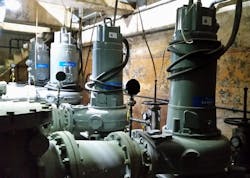New Jersey Town Sticks with a Winner
The mayor and council of Kearny, N.J., created the Kearny Municipal Utilities Authority (KMUA) in May 1988. KMUA is responsible for the collection of wastewater from portions of the Meadowlands and South Kearny sections of the town. It also is responsible for screening solids from the wastewater and pumping it to the Passaic Valley Sewerage Commission (PVSC) in Newark, N.J., for final treatment. KMUA maintains one 17.5-mgd pumping station in South Kearny–the Kearny Point Pump Station—and three smaller pumping stations in the Kearny Meadowlands. The Kearny Point Pump Station was outfitted with four Flygt dry pumps in the early 1990s.
Scope
In 2004, a major flood severely damaged the station when it submerged the pump controls. Increasing flows also exceeded the facility’s capacity during extreme weather events. The pump station did not have a functional grit removal system, which led to grit deposits at the treatment plant. As a result, the existing Parshall flume used for metering flows to the PVSC was inaccurate, impacting the calculation of service charges.
The pump station’s wet well routinely surcharged during high-flow events, creating the need for increased maintenance. The writing was on the wall that the station needed to be upgraded.
Solution
In 2004, KMUA retained Mott MacDonald as the prime consultant to provide engineering services for the rehabilitation of the Kearny Point Pump Station. The proposed work included restoring the building structure and the process equipment to a fully functional and efficient operation. By preparing preliminary documents within only 60 days due to a consent order, the consultant saved more than $1 million in financing costs for the project.
Results
The design team modified the existing wet-well channels to accommodate redundant chain and flight grit removal equipment, grit sumps, grit pumps, and motorized sluice and slide gates with controls to regulate flow into the pump station and individual channels. A new 18-in. Parshall flume was installed so that the full range of flows could be measured accurately. A temporary bypass pumping system with flow metering was designed to enable the construction of the new facilities.
After a lengthy service life and surviving Superstorm Sandy in 2012, it was determined that the four large Flygt dry pit pumps also needed to be upgraded. KMUA had been so pleased and impressed with the pumps, as well as local service available from Flygt distributor Pumping Services Inc., that it worked closely with its engineer to specify the replacement units around the existing pumps.
KMUA’s contractor, Coppola Services, purchased and installed two 110-hp N-pump 3306s and two 135-hp NT3312 replacement pumps. These two N-pumps feature self-cleaning N-impellers that deliver high efficiency, reducing both energy bills and maintenance costs. The life-cycle cost of the N-pumps is extremely beneficial to the utility. These benefits have been proven at dozens of other utilities worldwide.
Solid objects entering the pump pass through the impeller between its vanes. If an object gets caught on the leading edge of one of the vanes, it will slide along the backswept shape and out the volute. The high efficiency of the N-pump is sustained over time due to its self-cleaning design.
To increase operational reliability, an inspection chamber between the seal unit and the bearings enables rapid spot checks and maintenance. Additional improvements, such as a biofuel generator and a new actuated gate valve on the force main, were installed as hazard mitigation features to improve pump station operations and increase resiliency. Construction of the $4-million rehabilitation project began in 2015 and was completed in 2017.
Editor's Note: Scranton Gillette Communications and the SGC Water Group are not liable for the accuracy, efficacy and validity of the claims made in this piece. The views expressed in this content do not reflect the position of the editorial teams of Water & Wastes Digest, Water Quality Products and Storm Water Solutions.
